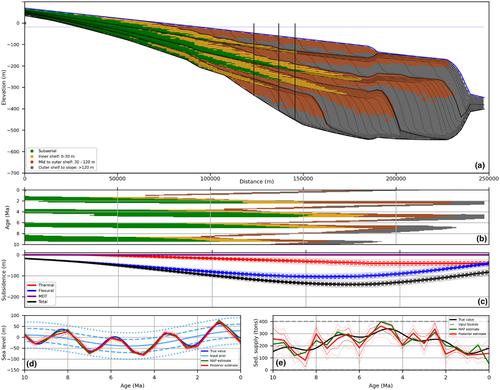当前位置:
X-MOL 学术
›
Basin Res.
›
论文详情
Our official English website, www.x-mol.net, welcomes your
feedback! (Note: you will need to create a separate account there.)
Sensitivity of modelled passive margin stratigraphy to variations in sea level, sediment supply and subsidence
Basin Research ( IF 2.8 ) Pub Date : 2024-02-19 , DOI: 10.1111/bre.12854 William J. Schmelz 1 , Kenneth G. Miller 1 , Gregory S. Mountain 1 , Michael S. Steckler 2 , James V. Browning 1
Basin Research ( IF 2.8 ) Pub Date : 2024-02-19 , DOI: 10.1111/bre.12854 William J. Schmelz 1 , Kenneth G. Miller 1 , Gregory S. Mountain 1 , Michael S. Steckler 2 , James V. Browning 1
Affiliation

|
We produced a 10 Myr synthetic stratigraphic section using a forward stratigraphic model that generates marine deltaic stratigraphy over geological timescales. We recursively fit the model using a Bayesian inversion algorithm to test: (1) if it could be accurately reconstructed; (2) if the parameters used to create it could be recovered; and (3) the sensitivity of the model output to given model parameters and the attendant physical processes. The original synthetic stratigraphic section was produced with cyclical sea‐level variations of 40 and 30 m with 2.4 and 10 Myr periods respectively. Sediment was also supplied cyclically, in 2.4 and 10 Myr cycles with amplitudes of 30 and 80 tons/100 kyr, respectively, varying from a mean of 232 tons/100 kyr. Parameter values were sampled to fit the model using a Markov chain Monte Carlo algorithm, resulting in a ±5 m (1σ) variation between the experimental output and the original. Sea level varied by ±7 m (1σ) within the posterior distribution of parameters. As a result, both the 10 Myr and 2.4 Myr sea‐level cycles could be extracted from the original output. The variation in sediment supply was approximately ±38 tons/100 kyr (1σ) and, as a result, only the larger long‐term supply variations could be accurately recovered in refitting the model. The variation in thermal, flexural and total subsidence across those parameter sets is less than ±10 m (1σ). The original section experienced 150 m of total subsidence at the depocentre. Our results demonstrate the distinct and interpretable imprint of sea level and subsidence on continental margin stratigraphy can be quantified. Moreover, we conclude that sea‐level change produces a defined effect on the geometries of stratigraphic architecture, and that techniques applied for the purpose of delineating sea‐level variation from continental margin strata have a well‐founded conceptual basis.
中文翻译:

模拟被动边缘地层学对海平面、沉积物供应和沉降变化的敏感性
我们使用正演地层模型生成了 10 Myr 合成地层剖面,该模型在地质时间尺度上生成海洋三角洲地层。我们使用贝叶斯反演算法递归地拟合模型来测试:(1)是否可以准确地重建;(2) 用于创建它的参数是否可以恢复;(3) 模型输出对给定模型参数和随之而来的物理过程的敏感性。原始合成地层剖面的海平面周期性变化为 40 和 30 m,周期分别为 2.4 和 10 Myr。沉积物也是周期性供应的,周期为 2.4 和 10 Myr,幅度分别为 30 吨/100 kyr 和 80 吨/100 kyr,平均值为 232 吨/100 kyr。使用马尔可夫链蒙特卡罗算法对参数值进行采样以拟合模型,从而导致实验输出与原始输出之间存在 ±5 m (1σ) 的变化。海平面在参数后验分布内变化 ±7 m (1σ)。因此,10 Myr 和 2.4 Myr 海平面周期都可以从原始输出中提取。沉积物供应的变化约为±38吨/100 kyr (1σ),因此,在重新拟合模型时只能准确恢复较大的长期供应变化。这些参数组的热沉降、弯曲沉降和总沉降的变化小于 ±10 m (1σ)。原段在沉积中心经历了 150 m 的总沉降。我们的结果表明,海平面和沉降对大陆边缘地层学的独特且可解释的影响是可以量化的。此外,我们得出的结论是,海平面变化对地层结构的几何形状产生了明确的影响,并且用于描绘大陆边缘地层海平面变化的技术具有坚实的概念基础。
更新日期:2024-02-19
中文翻译:

模拟被动边缘地层学对海平面、沉积物供应和沉降变化的敏感性
我们使用正演地层模型生成了 10 Myr 合成地层剖面,该模型在地质时间尺度上生成海洋三角洲地层。我们使用贝叶斯反演算法递归地拟合模型来测试:(1)是否可以准确地重建;(2) 用于创建它的参数是否可以恢复;(3) 模型输出对给定模型参数和随之而来的物理过程的敏感性。原始合成地层剖面的海平面周期性变化为 40 和 30 m,周期分别为 2.4 和 10 Myr。沉积物也是周期性供应的,周期为 2.4 和 10 Myr,幅度分别为 30 吨/100 kyr 和 80 吨/100 kyr,平均值为 232 吨/100 kyr。使用马尔可夫链蒙特卡罗算法对参数值进行采样以拟合模型,从而导致实验输出与原始输出之间存在 ±5 m (1σ) 的变化。海平面在参数后验分布内变化 ±7 m (1σ)。因此,10 Myr 和 2.4 Myr 海平面周期都可以从原始输出中提取。沉积物供应的变化约为±38吨/100 kyr (1σ),因此,在重新拟合模型时只能准确恢复较大的长期供应变化。这些参数组的热沉降、弯曲沉降和总沉降的变化小于 ±10 m (1σ)。原段在沉积中心经历了 150 m 的总沉降。我们的结果表明,海平面和沉降对大陆边缘地层学的独特且可解释的影响是可以量化的。此外,我们得出的结论是,海平面变化对地层结构的几何形状产生了明确的影响,并且用于描绘大陆边缘地层海平面变化的技术具有坚实的概念基础。


















































 京公网安备 11010802027423号
京公网安备 11010802027423号